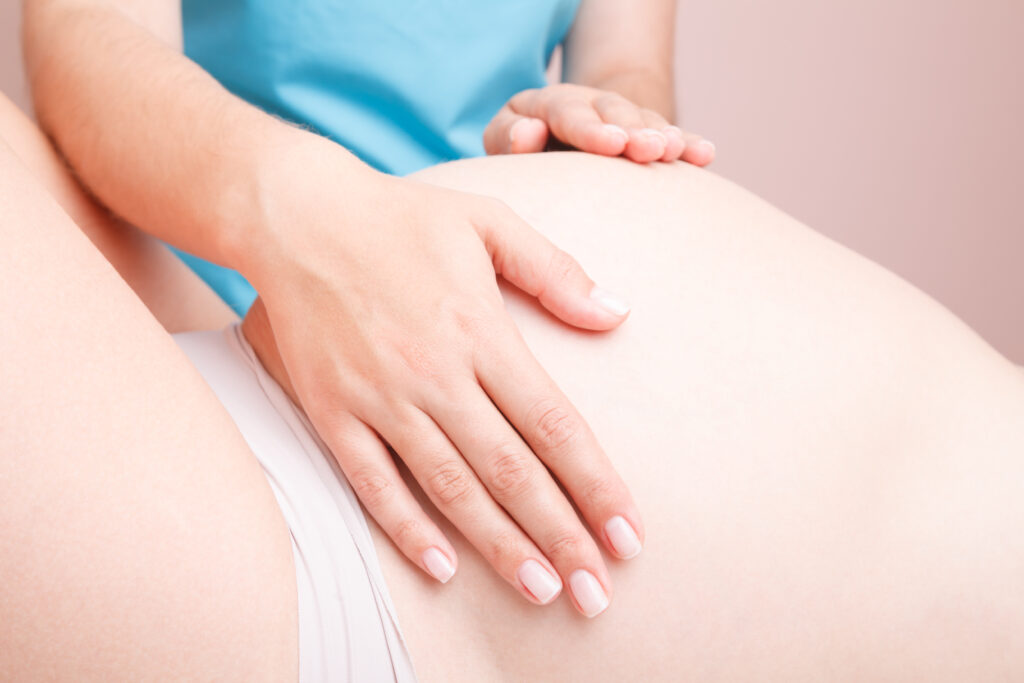Pregnancy is a beautiful and transformative experience for women, but it can also bring about certain challenges and discomforts.
One such challenge is pregnancy-related pelvic girdle pain (PGP), a condition that affects many expectant mothers.
Keep reading to understand the causes, symptoms, and what physio can do for pregnancy-related PGP.
What is pregnancy-related PGP?
Pregnancy-related PGP refers to pain and discomfort experienced in the pelvic region during pregnancy.
It commonly affects the sacroiliac joints, located at the back of the pelvis, as well as the pubic symphysis, a joint at the front of the pelvis.
The exact causes of PGP are not fully understood, but hormonal changes, increased joint mobility, and the additional weight and strain on the pelvic area are believed to contribute to its development.
What are the symptoms?
Pregnancy-related PGP can manifest in various ways, and its severity may vary from woman to woman.
Some common symptoms include:
- Pain in the lower back, buttocks, hips, or groin
- Aching or sharp pain around the pubic area
- Difficulty walking, climbing stairs, or turning in bed
- Pain during activities such as lifting, standing, or sitting for prolonged periods
- Popping or clicking sensations in the pelvic region

How can physio help?
While pregnancy-related PGP can be challenging, physiotherapy can play a crucial role in managing this condition, providing effective relief and support to expectant mothers.
- Exercise prescription to strengthen the muscles supporting the pelvis. These exercises focus on improving stability, posture, and overall function.
- Manual therapy to help reduce pain, restore joint function, and optimise movement patterns
- Education and postural advice to minimise pain and discomfort in different positions
- Prescription of pelvic support and bracing devices can help distribute the load more evenly, reducing pain and improving function
- Advice on pain management techniques, such as heat therapy, cold therapy, and massage to provide temporary relief from PGP
- Lifestyle modifications to apply to daily activities that may be aggravating PGP. They provide advice on posture, body mechanics, and movement patterns to reduce strain on the pelvic area.

Managing pregnancy-related pelvic girdle pain
Pregnancy-related pelvic girdle pain is a common condition that can impact expectant mothers’ daily lives and well-being.
By understanding the causes, recognising the symptoms, and implementing effective management strategies, women can find relief and navigate their pregnancy journey with greater comfort and confidence.
If you are experiencing pregnancy-related PGP, consult a physiotherapist who specialises in women’s health to develop a personalised treatment plan that addresses your unique needs!
Learn more about pregnancy and postnatal physiotherapy, or, find a Lifecare clinic near you.
Beeta Tira BPhty
References
- Gutke A, Ostgaard HC, Oberg B. Pelvic girdle pain and lumbar pain in pregnancy: a cohort study of the consequences in terms of health and functioning. Spine (Phila Pa 1976). 2006;31(5):E149-155.
- Haakstad LA, Torset B, Bø K. What is the effect of regular group exercise on maternal psychological outcomes and common pregnancy complaints? An assessor blinded RCT. Midwifery. 2016;34:169-175.
- Mogren IM, Pohjanen AI. Low back pain and pelvic pain during pregnancy: prevalence and risk factors. Spine (Phila Pa 1976). 2005;30(8):983-991.
- Pennick V, Liddle SD. Interventions for preventing and treating pelvic and back pain in pregnancy. Cochrane Database Syst Rev. 2013;(8):CD001139.
- To WW, Wong MW. Factors associated with the use of maternity support belt in pregnant women. Patient Prefer Adherence. 2013;7:1107-1112.
- Vleeming A, Albert HB, Ostgaard HC, et al. European guidelines for the diagnosis and treatment of pelvic girdle pain. Eur Spine J. 2008;17(6):794-819.

